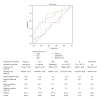Endocan levels in peripheral blood predict outcomes of acute respiratory distress syndrome
- PMID: 25132734
- PMCID: PMC4124235
- DOI: 10.1155/2014/625180
Endocan levels in peripheral blood predict outcomes of acute respiratory distress syndrome
Abstract
Purpose: To investigate the prognostic significance of endocan, compared with procalcitonin (PCT), C-reactive protein (CRP),white blood cells (WBC), neutrophils (N), and clinical severity scores in patients with ARDS.
Methods: A total of 42 patients with ARDS were initially enrolled, and there were 20 nonsurvivors and 22 survivors based on hospital mortality. Plasma levels of biomarkers were measured and the acute physiology and chronic health evaluation II (APACHE II) was calculated on day 1 after the patient met the defining criteria of ARDS.
Results: Endocan levels significantly correlated with the APACHE II score in the ARDS group (r = 0.676, P = 0.000, n = 42). Of 42 individuals with ARDS, 20 were dead, and endocan was significantly higher in nonsurvivors than in survivors (median (IQR) 5.01 (2.98-8.44) versus 3.01 (2.36-4.36) ng/mL, P = 0.017). According to the results of the ROC-curve analysis and COX proportional hazards models, endocan can predict mortality of ARDS independently with a hazard ratio of 1.374 (95% CI, 1.150-1.641) and an area of receiver operator characteristic curve (AUROC) of 0.715 (P = 0.017). Moreover, endocan can predict the multiple-organ dysfunction of ARDS.
Conclusion: Endocan is a promising biomarker to predict the disease severity and mortality in patients with ARDS.
Figures


References
-
- Phua J, Badia JR, Adhikari NKJ, et al. Has mortality from acute respiratory distress syndrome decreased over time? American Journal of Respiratory and Critical Care Medicine. 2009;179(3):220–227. - PubMed
-
- Rubenfeld GD, Herridge MS. Epidemiology and outcomes of acute lung injury. Chest. 2007;131(2):554–562. - PubMed
-
- Herridge MS, Tansey CM, Matté A, et al. Functional disability 5 years after acute respiratory distress syndrome. The New England Journal of Medicine. 2011;364(14):1293–1304. - PubMed
-
- Stüber F, Wrigge H, Schroeder S, et al. Kinetic and reversibility of mechanical ventilation-associated pulmonary and systemic inflammatory response in patients with acute lung injury. Intensive Care Medicine. 2002;28(7):834–841. - PubMed
Publication types
MeSH terms
Substances
LinkOut - more resources
Full Text Sources
Other Literature Sources
Medical
Research Materials
Miscellaneous

